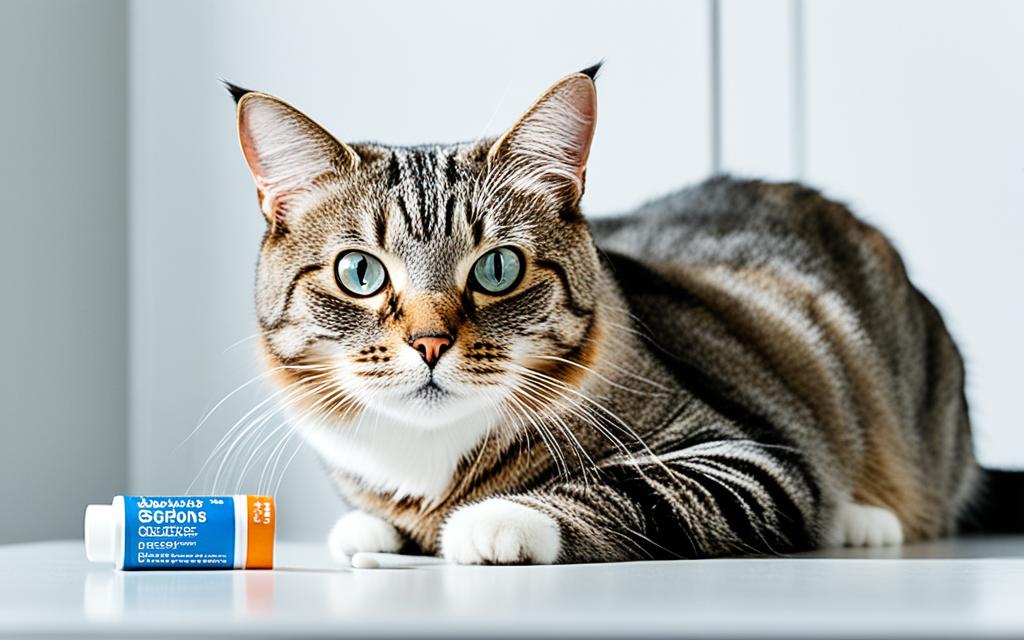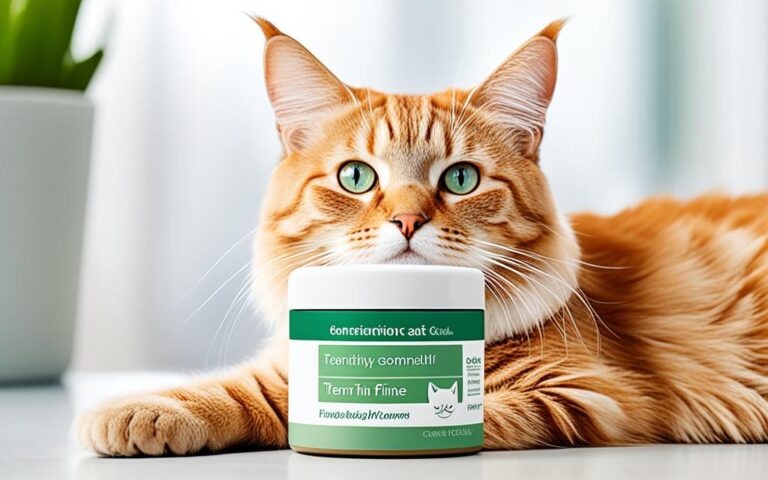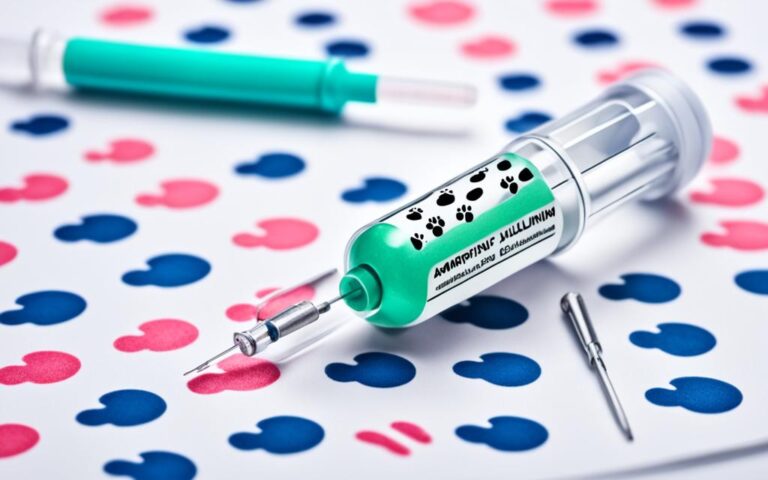Minocycline for cats: Acne Treatment & Antibiotic Uses
Minocycline is a tetracycline antibiotic often chosen to fight bacterial infections in cats, dogs, and horses1. It’s great for dealing with things like feline acne and tick-borne diseases. More and more, pet owners and vets are delving into the benefits of using minocycline. They make sure to learn about how it’s used, how much to give, and what side effects may pop up. This is key to keeping our furry friends safe and sound.
Key Takeaways
- Minocycline is a tetracycline-based antibiotic commonly used to treat bacterial infections in cats, dogs, and horses.
- It is often prescribed as an alternative to doxycycline (Vibramycin®) and is frequently used for heartworm adulticide treatment.
- Minocycline can be effective in treating tick-borne illnesses like Lyme disease in pets.
- While its use in pets is considered “off-label”, veterinarians frequently prescribe minocycline for various infections.
- Understanding the proper dosage, potential side effects, and monitoring requirements is crucial for the safe administration of minocycline to cats.
Table of Contents
What is Minocycline?
Definition and Overview
Minocycline is a widely used antibiotic. Doctors prescribe it for different bacterial infections in people and animals2. This medicine stops bacteria from making proteins, which either kills them or stops their growth2. It’s known for working against many kinds of bacteria, as well as certain other tiny organisms3.
Besides fighting infections, minocycline also shows benefits beyond killing bacteria. It helps reduce inflammation, prevents cell death, and protects nerves3. Because of these extra effects, it can be used for more than just treating infections. Doctors use it for diseases involving inflammation, the immune system, and nerve cells3.
Brand Names and Forms
Minocycline goes by several brand names, like Minocin®, Solodyn®, and others. You can get it as capsules, tablets, and even in liquids2. This variety in forms means doctors can choose the best way to give the medicine to each patient2.
| Brand Name | Dosage Form |
|---|---|
| Minocin | Capsules, Tablets |
| Solodyn | Extended-Release Tablets |
| Arestin | Oral Suspension |
| Cleeravue-M | Capsules |
| Dynacin | Capsules |
| Minolira | Extended-Release Tablets |
| Myrac | Capsules |
| Ximino | Extended-Release Capsules |
With different forms available, healthcare providers can pick the best option for each patient2.
Minocycline for cats
Minocycline is a type of antibiotic often used in cats to fight bacterial infections456. Even though it’s not FDA-approved for them. It’s used for skin, urinary, and respiratory infections. It also helps with tick-borne diseases456.
This kind of use for cats is called “off-label.” That means it’s not the main use listed. But it’s a common and accepted practice by vets. They do this to help their feline patients45. Vets like using the benefits of certain drugs even if they aren’t originally for that purpose5.
| Veterinary Uses of Minocycline | Bacterial Infections Treated |
|---|---|
| Dogs | Rickettsia, Canine ehrlichiosis, Toxoplasma, Lyme disease |
| Cats | Bartonella, Mycoplasma, Dermatophilus, Mycobacteria |
| Horses | Ehrlichia, Anaplasma, Lyme disease |
Using minocycline in cats needs careful attention from vets456. They must give the right dose and watch for side effects456. This ensures it helps without hurting the cat456.
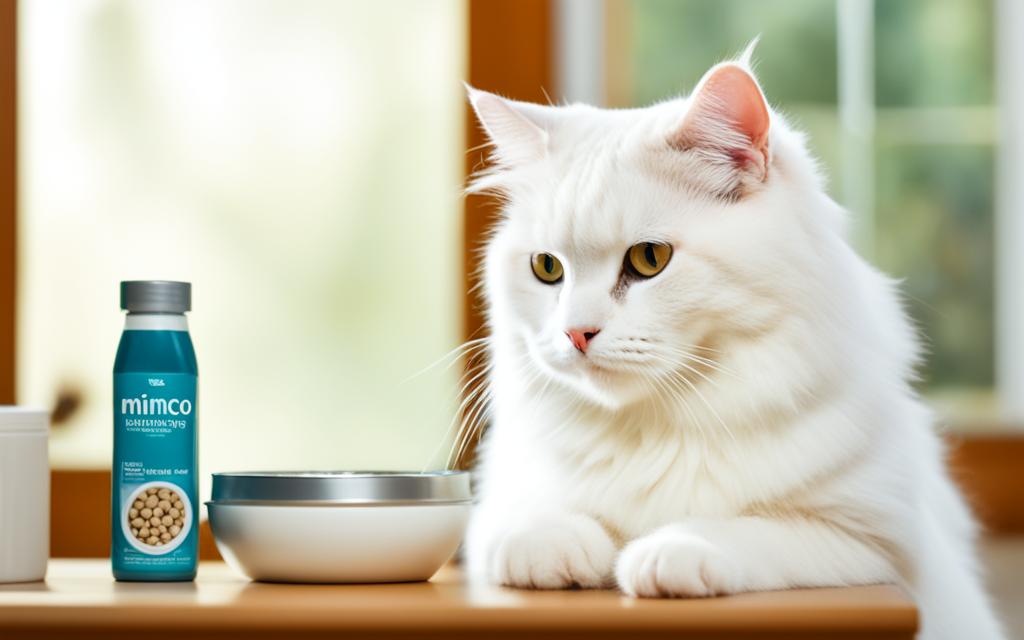
So, minocycline is not directly approved for cats, but it’s very helpful. Vet experts often choose it for bacterial infections. They know it can really make a difference in a cat’s health456.
Minocycline Uses and Benefits
Minocycline helps keep cats healthy by fighting off infection. It’s a go-to medication when vets need to address bacterial issues or acne in felines7.
Treating Bacterial Infections
This antibiotic is great for kicking out bacteria. Cats with skin, urinary, or respiratory problems, even Lyme disease, can benefit from it8. When usual antibiotics don’t work or can’t be used, minocycline steps in to fight the infection7.
Minocycline isn’t just for felines, it also keeps dogs safe from bacterial threats. It’s very good at handling tick-borne diseases and water-borne sicknesses like leptospirosis. Plus, it’s a key player in treating common pet infections78.
Acne Treatment for Cats
It’s also helpful for a common cat issue: acne. That’s right, cats can get blackheads and pimples too. Minocycline’s anti-inflammatory power helps with the swelling and redness, keeping those cat faces clear9.
For severe cases, minocycline often teams up with other acne meds. There’s also a type that’s made just for this issue, Solodyn. It’s proof that minocycline isn’t just for fighting bacteria but also for treating skin problems978.
Administering Minocycline to Cats
It’s very important to give minocycline to cats the right way. You must carefully think about how much they need and how often. This helps make the treatment work well and lowers the chance of side effects.
Dosage and Frequency
The starting dose for cats is usually 4 mg for each kilogram they weigh. They get this amount every 12 hours10. But, a vet might change this if it’s not working right for the cat10. Research tells us the average dose is 13.9 mg/kg, and 62% of it is used by the body1010.
Directions for Use
Cats take minocycline by mouth in a capsule, tablet, or liquid. Always do what the vet says when giving it. It should be given with a meal or right after to keep the stomach from getting upset10.
Never give minocycline to a cat as a dry pill. It could get stuck in their throat and cause damage11. Always give it with a bit of food or a drink so they swallow it safely11.
About 60% of minocycline attaches to proteins in the blood at 5 µg/ml. As the concentration drops to 1 μg/ml, this binding reduces to 46%. This shows it can move around the body and work where it’s needed1010.
| Medication | Median Retail Price |
|---|---|
| Minocycline Compound | $1.40 to $62.5011 |
| Ceraven/ CeraSoothe CH | $22.9911 |
| Doxycycline | $1.49 to $1.6511 |
| Nitrofurantoin Macrocrystal | $2.00 to $6.9511 |
| Atopica for Dogs | $44.92 to $131.8111 |
| Minocycline Ophthalmic | $19.9511 |
| Albuterol Inhalation Solution | $21.9911 |
| Vitamin B12 Injectable | $14.2911 |
| MiconaHex+Triz Wipes | $25.9911 |
| Mal-A-Ket Wipes | $29.9511 |
After giving minocycline straight into a vein, it takes about 6.7 hours for half of it to leave the body. The steady-state volume it spreads out to is 1.5 l/kg1010. The body removes it at a rate of 2.9 ml/kg/min after this method1010.
By mouth, minocycline sticks around for about 6.3 hours before half is gone. At its highest level in the blood, it reaches 4.77 μg/ml1010. This suggests cats should take 8.8 mg for each kilogram they weigh, once a day. This covers how it binds to proteins and how that affects the treatment10.
For most cats, giving them one 50 mg capsule every day is enough10.
“It’s very important to give minocycline to cats the right way. Refer to a vet to figure out the correct dosage and timing. This is crucial for the cat’s health and to avoid side effects.”
Potential Side Effects and Precautions
When giving minocycline to cats, it’s good for pet owners to know the possible side effects. The common ones are feeling sick, throwing up, eating less, and runny poop12. Yet, there are rare but serious issues like liver problems, ear trouble, and bad stomach effects12. Minocycline can also make a cat more likely to get sunburnt on their skin that’s not covered12.
There are special steps to take when cats need minocycline. Cats that had liver or kidney troubles before, plus younger cats, may require closer watching with this drug12. If a cat is going to have kittens, it’s important to know that minocycline might stain their baby teeth12.
Minocycline can react badly with other meds like antacids and iron. If a cat takes too much, they might feel dizzy, sick, or start throwing up. In this case, calling the poison control center or getting emergency help is the right move12.
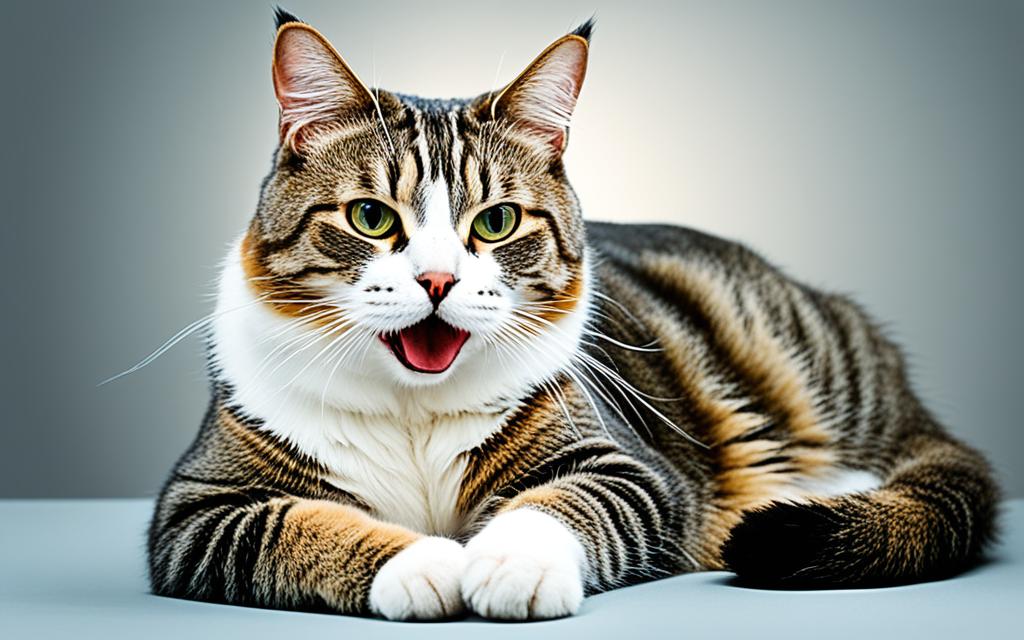
It’s vital for pet owners to stick to the vet’s advice and keep an eye on their cat’s reaction to minocycline12. Knowing the risks and being careful makes sure minocycline is safe and works well for a cat12.
Comparing Minocycline with Other Antibiotics
When treating bacterial infections and skin problems in cats, minocycline is often compared to doxycycline. They both belong to tetracycline antibiotics with similar benefits for cat health13.
Efficacy Comparison
Studies show minocycline might work better than doxycycline for conditions like rosacea. It may also help cats stay better longer. Yet, doxycycline is given more often13.
Cost and Availability
Minocycline is usually less expensive than some antibiotics. It’s around $130, or about $37 with a coupon. Doxycycline might be over $200, but a coupon can lower it to $3113.
Most clinics and pet stores have minocycline. It being easy to get and cheap makes it a top pick for many cat issues.
| Antibiotic | Efficacy | Cost (Out-of-pocket) | Availability |
|---|---|---|---|
| Minocycline | More effective in treating rosacea, with better improvement scores and longer remission periods13 | Typically around $130, can drop to about $37 with a coupon13 | Widely available in most veterinary clinics and pet pharmacies13 |
| Doxycycline | Prescribed about three times more often than minocycline13 | Can cost over $200 out-of-pocket, but with a coupon can be as low as $3113 | Widely available |
Choosing between minocycline and doxycycline depends on the cat’s illness, history, and the vet’s advice. Think about how well it works, its cost, and how easy it is to find.
Minocycline Mechanism of Action
Minocycline is a member of the tetracycline family. It stops bacteria by affecting how they make protein14. The medicine attaches to the 30S part of a bacterial ribosome. This action stops amino acids from adding to the protein chain, which the bacteria needs to survive14.
This process kills bacteria or slows their growth14. Apart from fighting bacteria, minocycline has other benefits14. It’s known to lower inflammation and stop cell death. It can also lower the body’s immune response in certain situations14.
Minocycline is also good for the brain. It helps fight brain inflammation that can lead to diseases like Alzheimer’s14. It does this by controlling certain enzymes that cause inflammation14.
Another interesting fact is that minocycline fights against cancer. It blocks an important enzyme needed for tumors to spread or create blood vessels14. Moreover, it helps improve memory and the growth of new brain cells. This makes it useful for treating brain conditions14.
In conclusion, minocycline does much more than kill bacteria14. It’s a powerful medicine that can reduce inflammation, change the immune response, and protect the brain. These effects offer a wide range of treatments for many health issues14.
Drug Interactions and Monitoring
When you give cats minocycline, be careful of drug interactions. These can make the medicine less effective or cause more side effects15. Some medicines, like antacids or bismuth (found in Pepto-Bismol®), can stop minocycline from working right. Others, such as digoxin or warfarin, might not work well if taken with minocycline15. It’s best to give minocycline an hour before or after these meds15.
Medications to Avoid
- Antacids
- Bismuth (Pepto-Bismol®)
- Gastro protectants (e.g., sucralfate)
- Digoxin
- Oral iron or zinc
- Penicillins
- Warfarin
Monitoring Requirements
Vets may keep an eye on cats taking minocycline. The vet might do physical exams or blood tests to check how well the medicine is working15. Owners need to look out for side effects like sickness, diarrhea, or unusual behavior. If these happen, tell the vet straight away15.
“Doctors need to check cats often when they’re on minocycline. They do tests to see if the medicine is working and to watch for side effects.”16
It’s vital to know minocycline can mix badly with some drugs. Being careful with the dose helps avoid trouble16. It can also make some health issues, like diarrhea or liver problems, worse16. Vets will make sure cats on minocycline are safe and getting the right benefit from the medicine15.
Storage and Handling
To keep minocycline working well and safe, handle and store it right. This antibiotic is often used for cats. It comes in different forms like tablets and capsules. Always follow the vet’s advice on how to take care of it17.
Minocycline should stay in a closed container at room temp, which is between 68°F and 77°F. It should be away from light17. Make sure kids and pets can’t get to it. This helps avoid accidents or wrong use18.
Minocycline has different amounts and looks. It might be 50 mg, 75 mg, or 100 mg. Shapes can be oval, oblong, or round. And you might see it in colors like pink, white, or yellow19. Always check the label for how to store each type. This is crucial for keeping it safe and working for your cat19.
Don’t share minocycline between pets or change the dose without your vet. It’s key to store it right to avoid misuse. This keeps the medicine working well for your cat17.
By doing what your vet says, you can make sure your cat gets the most from this medicine. But you’ll also lower the chances of side effects1718.
Missed Dose and Overdose Guidelines
What to Do If You Miss a Dose
If you forget to give your pet minocycline, do it as soon as you remember20. But, if it’s almost time for the next dose, skip the missed one. Never give your cat two doses to make up for the missed one. This avoids the risk of an overdose21.
Overdose Symptoms and Emergency Care
Think your cat took too much minocycline? Reach out to the vet or a poison control center right away20. Look out for signs like lots of vomiting, diarrhea, weakness, and being really tired20. Getting your cat medical help fast is key to avoid severe issues or death20. The vet might advise you to come in at once for special care20.
Did your cat swallow too much minocycline? Act fast and get expert help21. An overdose of minocycline is very serious and needs immediate professional treatment21.
Conclusion
Minocycline is a powerful antibiotic for cats. It works well against many types of infections like skin, breathing, and bladder problems, and even feline acne22. Though not directly meant for cats, it’s often recommended by vets for its good results22. When using this medicine, it’s vital to follow the vet’s advice on dose, side effects, and other medicines that might interfere with it22.
Research shows minocycline fights a wide range of harmful bacteria in cats, such as Bordetella, Listeria, and Pasteurella22. It’s also better than doxycycline against a serious type of bacteria called methicillin-resistant Staphylococcus pseudintermedius23. This shows how minocycline is very useful for treating many different problems in cats.
To sum up, even though minocycline’s use in cats is not the usual, it can offer significant benefits under a vet’s care22. It’s known for its wide protection and success against tough germs, highlighting its value in keeping cats healthy2223.
FAQ
What is minocycline?
How is minocycline used in veterinary medicine?
What are the uses and benefits of minocycline for cats?
How is minocycline administered to cats?
What are the potential side effects and precautions of using minocycline in cats?
How does minocycline compare to other antibiotics used in cats?
How does minocycline work to kill bacteria?
What precautions should be taken when using minocycline in cats?
How should minocycline be stored and handled for use in cats?
What should be done if a dose of minocycline is missed or if an overdose occurs?
Source Links
- Minocycline 100 mg 1 Capsule
- Considerations for using minocycline vs doxycycline for treatment of canine heartworm disease – Parasites & Vectors
- Minocycline: far beyond an antibiotic
- Minocycline | VCA Animal Hospitals
- Minocycline for Dogs and Cats
- Uses, Dosage & Side Effects
- Minocycline HCl (Generic)
- Minocycline (Minocin®, Dynacin®) for Dogs and Cats
- Minocycline: MedlinePlus Drug Information
- Pharmacokinetics of minocycline in domestic cats
- Minocycline HCL Caps | PetMart Pharmacy
- Minocycline: MedlinePlus Drug Information
- Minocycline vs. doxycycline: Which is better?
- Minocycline powder 13614-98-7
- Minocycline | VCA Animal Hospitals
- Minocycline (Oral Route) Side Effects
- Minocycline for Dogs, Cats, Horses
- Minocycline Oral: Uses, Side Effects, Interactions, Pictures, Warnings & Dosing – WebMD
- Doxycycline
- Uses, Dosage, and Side Effects
- Minocycline as Doxycycline Alternative

